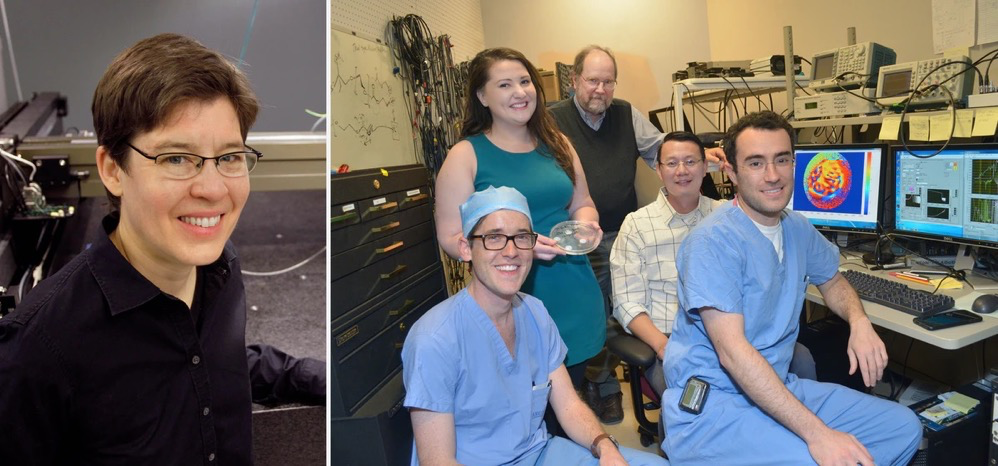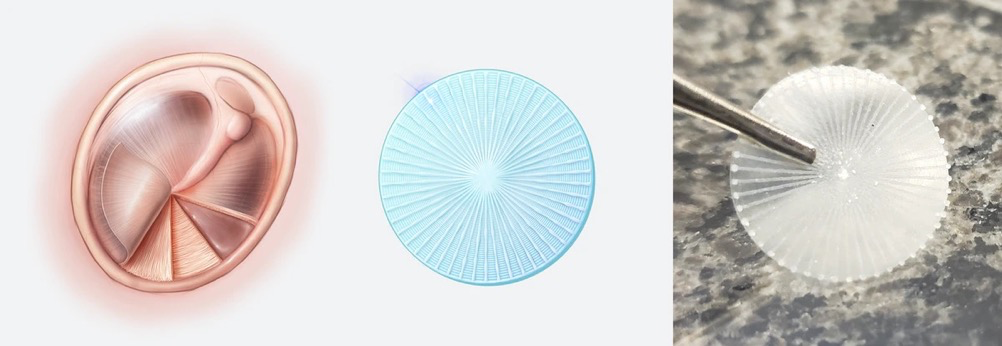The PhonoGraft biomimetic hearing-restoration technology, advanced through a six-year effort by a multidisciplinary research team at the Wyss Institute for Biologically Inspired Engineering, Harvard’s John A. Paulson School of Engineering and Applied Sciences (SEAS), and Massachusetts Eye and Ear (MEE)/Mass General Brigham (MGB), has now entered commercial development. If successful, it could mitigate pain, drainage, and hearing loss associated with eardrum perforations that affect millions of individuals worldwide.
Following the acquisition of the team’s startup company, Beacon Bio, California-based Desktop Health, a healthcare business within Desktop Metal Inc. that focuses on new 3D printing and biofabrication solutions for personalized medicine, was granted an exclusive license by Harvard’s Office of Technology Development (OTD). Nicole Black, Ph.D. ’20, who was CEO of Beacon Bio, will continue to lead the platform as Vice President of Biomaterials and Innovation at Desktop Health.
The PhonoGraft device is a 3D printed, biocompatible graft that could be implanted to repair a damaged eardrum. If its clinical development is successful, the PhonoGraft technology could mitigate the pain, drainage, and hearing loss associated with eardrum perforations that affect millions of individuals worldwide.
The founding team of the PhonoGraft project included Wyss Institute and Harvard SEAS researchers Jennifer Lewis (headshot on the left), and Nicole Black holding a petri dish with four 3D printed devices, and MEE ear surgeons Aaron Remenschneider (front left) and Elliott Kozin (front right) in their MEE lab (photo on the right). Also shown are John Rosowski (background left), Director of the Wallace Middle-Ear Research Unit at Mass Eye and Ear, and Jeffrey Tao Cheng (background right). Credit: Wyss Institute at Harvard University, and Garyfallia Pagonis
The technology is now entering commercial development. Driven to make their innovations available to patients, entrepreneurial members of the research team launched a startup company, Beacon Bio, with an exclusive license from Harvard’s Office of Technology Development (OTD) to commercialize the PhonoGraft innovations co-owned by Harvard and Mass General Brigham. Beacon Bio was acquired this summer by California-based Desktop Health, a healthcare business within Desktop Metal Inc. that focuses on new 3D printing and biofabrication solutions for personalized medicine. Nicole Black, Ph.D. ’20, who was CEO of Beacon Bio, will continue to lead the platform as Vice President of Biomaterials and Innovation at Desktop Health.
Manufacturing on Demand
“I am absolutely thrilled to have Beacon Bio become a part of the Desktop Health team, and to see these innovations advance so far from their earliest days in the lab,” said Black, who is a co-inventor of the PhonoGraft technology and spearheaded its development at Harvard and MEE. “The general support, manufacturing expertise, and regulatory expertise of an established company will be key to bringing the PhonoGraft platform to patients and to developing a regenerative medicine platform around the technology.”
Shown on the left is an illustration of the native tympanic membrane with its pattern of radial and concentric collagen fibers. The team developed a synthetic polymer-based ink system that enabled them to 3D print a device mimicking that same pattern, as illustrated in the middle and shown as an actual 3D printed device on the right. Credit: Illustrations by Shawna Snyder, Photo by Wyss Institute at Harvard University
Black was initially a doctoral student at SEAS, studying materials science and bioengineering in the lab of Jennifer A. Lewis, Sc.D., the Hansjörg Wyss Professor of Biologically Inspired Engineering at SEAS and a Core Faculty member at the Wyss Institute. In developing the technology, the Lewis Lab teamed up with two surgeons at MEE: Aaron Remenschneider, M.D., M.PH., and Elliott Kozin, M.D. Going forward, Lewis, Remenschneider, and Kozin will participate in the scientific advisory board of Desktop Health.
The eardrum, or tympanic membrane, is a thin membrane evolved to conduct sound in the ear and serves as a protective barrier against invading pathogens. The eardrum can become perforated by blasts, traumatic injuries, and chronic ear infections. Despite the eardrum’s remarkable self-healing powers, many perforations cannot heal by themselves and require reconstructive “tympanoplasty” procedures in which ear surgeons repair the hole with tissue grafts harvested from the patient. Even with modern techniques, surgical failures are common, making revision surgeries necessary. Additionally, patient-derived tissue grafts have imperfect sound-conducting abilities, as their structure does not match that of the normal eardrum.
The researchers at Harvard and MEE designed the PhonoGraft technology to utilize a novel biomaterial-based approach that guides the regeneration of native eardrum tissue. Its 3D printed structure mimics the structure of a normal eardrum and effectively stimulates the tissue’s self-healing properties, as demonstrated in animal models. The team believes the PhonoGraft material technology – unlike other methods – could potentially enable permanent repair by first closely mimicking and then restoring the eardrum’s sound-conducting mechanical properties and barrier functions.
* This article is reprinted from 3D Printing Media Network. If you are involved in infringement, please contact us to delete it.
Author: Davide Sher



Leave A Comment